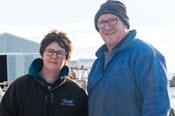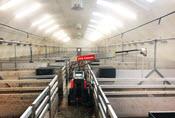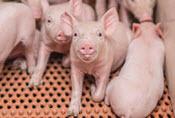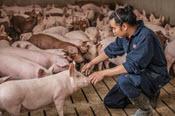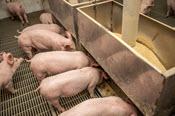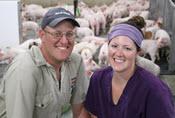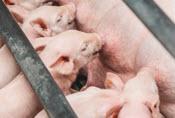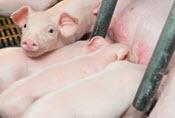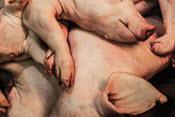Better Pork is published bimonthly. After each edition is published, we share two feature articles online. Each magazine includes much more content. If you enjoy reading the Better Pork articles below, be sure to subscribe to the magazine!
Producers can capitalize on renewed interest in eating local products by marketing directly to consumers
By Jackie Clark
In many parts of the food system, a large disconnect exists between the person who produces the food and the person who consumes it. However, some farmers are able to sell directly to customers and build a relationship with them.
Scientists at secure, high-containment laboratories around the world are continuing to work and share information to develop a vaccine that will protect against the deadly swine virus.
By Jackie Clark
Over the past year and a half, most of the world has been focused on the COVID-19 pandemic and the progress toward developing a safe and effective vaccine. However, for those in the pork industry, a parallel effort is underway to find a vaccine to protect against African swine fever (ASF).
Progress Means Profit for Producers
By Geoff Geddes
Somewhere there lives a farmer who isn’t short of time or money...just not in this solar system. In a pork business with rollercoaster pricing and razor thin margins, harnessing technology is critical to saving time and money, two things in short supply for pork farmers. Whether it’s ventilation, feed or labour, the latest advances can aid producers in staying sane, solvent and sustainable.
The bad, the worse and the deadly.
By Jackie Clark
Scouring is an unpleasant reality that pork producers around the world face. Diarrhea in piglets can be caused by a variety of pathogens and can lead to consequences for the individual piglet’s growth and productivity, survivability, as well as general herd health.
Better Pork connects with veterinarians and researchers to examine how farmers are preventing and treating scours and current research working to improve and expand those options.
Genetic advances will get us there.
By Geoff Geddes
While “faster, higher, stronger” is the Olympic motto, it is “leaner, healthier and more efficient” that serves as the gold standard for the pork sector. In a business where margins are thin and progress is essential, the role of genetics to fuel that progress is a critical one. Though genetic technology is complex and fraught with challenges, it holds the key to keeping producers competitive both at home and abroad.
New hybrid rye lowers risk of ergot in feed rations.
By Michelle Jones
Rye isn’t used a lot in pig rations, mostly because there isn’t a lot of it grown in Canada due to its susceptibility to ergot. While other grains such as wheat and barley are also prone to the disease, ergot seems to affect rye more often, so farmers have been hesitant to grow it or use it as feed because of the risk involved. However, research was still conducted on the nutritional value of rye, even if it wasn’t widely used as feed.
Industry stakeholders explore options to help curb rising feed expenses.
By Geoff Geddes
Unlike a barn upgrade or enhanced ventilation, feed for your pigs is not an optional expense. The right quantity and quality of feed is essential to proper growth, but as feed prices rise, so does the blood pressure of producers when trying to balance the books.
Transitioning from weekly farrowing to batches could benefit pig health, workflow and biosecurity.
By Jackie Clark
Most pig farms across Canada run on a continuous schedule: breeding, farrowing, processing piglets, and weaning all happen each week. Many producers find success and satisfaction in this steady rhythm of work.
Breeding targets are the basis for profitability in reproductive herds. Learn how to achieve optimal productivity on your farm.
by Kate Ayers
Swine reproductive herd management can be challenging yet rewarding work. Helping a sow produce a large healthy litter of piglets can be accompanied by a demanding and frustrating process of successfully bringing a gilt into her first breeding season.
The Canadian pork industry hopes to avert the prospect of a large volume of dead pigs, but officials are preparing in the event of a major disease outbreak.
by Jackie Clark
Disposing of dead livestock is an unpleasant task at best. However, being able to do so safely and efficiently is a reality for swine producers across Canada. The task requires technical knowledge and access to resources such as deadstock bins or composting materials.



